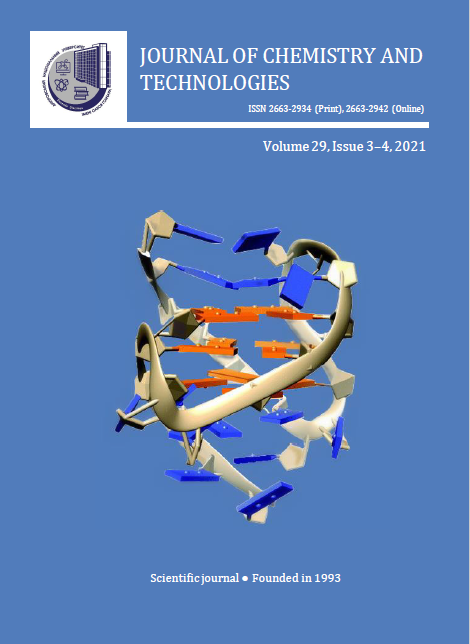RESEARCH ON A NEW APPROACH TO LOW-TEMPERATURE DEODORIZATION AND ITS EFFECT ON OXIDATIVE DETERIORATION OF FISH OIL
DOI:
https://doi.org/10.15421/jchemtech.v29i4.238356Keywords:
fish oil, deodorization methods, sensory evaluation, peroxides, aldehydesAbstract
The high content of docosahexaenoic acid and eicosapentaenoic acid in fish oil explains the benefits of this type of fat, especially for the health of the cardiovascular system and the brain.
However, the incorporation of fish oil into foods and beverages is often challenging, as fish oil oxidizes very easily and can cause undesirable flavors. An alternative method for deodorizing fish oil has been proposed and investigated. The method is based on the chemical transformation of the main odoriferous compounds of fish oil - aldehydes and ketones. Under the influence of ethyl alcohol and an acid catalyst, more volatile acetals and ketanals are formed. The obtained fish oil tastes and smells in accordance with the requirements for deodorized oils. Aldehydes are also the main secondary products of fish oil oxidation, which are responsible for the so-called "rancidity". The possibility of restoring the sensory characteristics of oxidized fish oil has been proven: the taste and smell of rancid oil disappears, the sensory profile corresponds to fresh fish oil.
References
Wu, N., Fu, X., Zhuang, K., Wu, X., Wang, X. (2018). Effects of dietary replacement of fish oil by vegetable oil on proximate composition and odor profile of hepatopancreas and gonad of Chinese mitten crab (Eriocheir sinensis). J Food Biochem., 43(10), e12646. https://doi.org/10.1111/jfbc.12646.
Fournier, V., Destaillats, F., Lambelet, P., Dionisi, F., Sebedio, J.L., Berdeaux, O. (2007). Degradation products formed from long-chain PUFA during deodorization of fish oil. Lipid Technology, 19(1), 9–11. https://doi.org/10.1002/lite.200600003.
Fang, Y., Gu, S., Zhang, J., Liu, S., Ding, Y., Liu, J. (2017). Deodorisation of fish oil by nanofiltration membrane process: focus on volatile flavour compounds and fatty acids composition. International Journal of Food Science & Technology, 53(3), 692–699.
https://doi:10.1111/ijfs.13644.
Song, G., Zhang, M., Peng, X., Yu, X., Dai, Z., Shen, Q. (2018). Effect of deodorization method on the chemical and nutritional properties of fish oil during refining. LWT, 96, 560–567.
https://doi:10.1016/j.lwt.2018.06.004.
Temime, S. B., Campeol, E., Cioni, P. L., Daoud, D., Zarrouk, M. (2006). Volatile compounds from Chétoui olive oil and variations induced by growing area Food Chem, 99, 315–325.
https://doi.org/10.1016/j.foodchem.2005.07.046.
Volatile Compounds in Food. Available from. https://www.vcf-online.nl/VcfHome.cfm.
Menegazzo, M.L., Petenuci, M.E., Fonseca, G.G. (2014). Production and characterization of crude and refined oils obtained from the coproducts of Nile tilapia and hybrid sorubim processing. Food Chem., 157, 100-104. https://doi.org/10.1016/j.foodchem.2014.01.121.
Song, G., Dai, Z., Shen, Q., Peng, X., Zhang, M. (2017). Analysis of the Changes in Volatile Compound and Fatty Acid Profiles of Fish Oil in Chemical Refining Process. European Journal of Lipid Science and Technology, 120(2), 1700219. https://doi:10.1002/ejlt.201700219
Rubio-Rodriguez, N., Diego, S. M., Beltrán, S., Jaime, I., Sanz, M. T., Rovira, J. (2012). Supercritical fluid extraction of fish oil from fish by-products: a comparison with other extraction methods. Journal of Food Engineering, 109(2), 238-248. https://doi:10.1016/j.jfoodeng.2011.10.011.
Zhao, L., Wu, W., Tao, N., Li, Y., Wu N., Qin X. (2015). Characterization of important odorants in four steamed Coilia ectenes from China by gas chromatography–mass spectrometry–olfactometry. Fisheries Science, 81, 947-957. https://doi:10.1007/s12562-015-0907-2.
TGSC Information System.
http://www.thegoodscentscompany.com/data/rw1000511.html.
Robert, J., Ouellette, J., Rawn. D. (2014). Organic Chemistry: Structure, Mechanism, and Synthesis. Aldehydes and Ketones: Nucleophilic Addition Reactions, 629-657. https://doi.org/10.1016/B978-0-12-800780-8.00019-X.
Kaufhold, M., El-Chahawi. M. Pat. DE 44 04 515 A1 (1995), to Huls AG, Germany.
Güner, M., Yılmaz, E., Yüceer, Y. (2019). Off-Odor Removal from Fish Oil by Adsorbent Treatment with Selected Metal-Organic Frameworks. Flavour and Fragrance Journal, 34(3), 163-174. https://doi:10.1002/ffj.3489.
Meskens, F.A.J. (1981). Synthesis, 501.
Nollet, Leo M.L., Toldra, F. Eds. (2010). Handbook of seafood and seafood products analysis. Taylor and Francis Group, LLC, 930.
Scientific Opinion on Fish Oil for Human Consumption. Food Hygiene, including Rancidity. (2010). EFSA Journal, 8(10), 1874.
https://doi:10.2903/j.efsa.2010.1874.
Vieira, S.A., Zhang, G., Decker, E.A. (2017). Biological implications of lipid oxidation products. Journal of the American Oil Chemists’ Society, 94 (3), 339–351. https://doi.org/10.1007/s11746-017-2958-2.
Miyashita, K., Uemura, M., Hosokawa, M. (2018). Effective Prevention of Oxidative Deterioration of Fish Oil: Focus on Flavor Deterioration. Annual Review of Food Science and Technology, 9, 209–226. https://doi.org/10.1146/annurev-food-030117-012320
GOED voluntary monograph. Version 7.1, issue date August 6, (2019).
https://goedomega3.com/storage/app/media/Governance%20docs/Monograph%20-%202019%2008%2006.pdf.
Damerau, A., Ahonen, E., Kortesniemi, M., Puganen, A., Tarvainen, M., Kaisa M. (2020). Linderborg. Evaluation of the composition and oxidative status of omega-3 fatty acid supplements on the Finnish market using NMR and SPME-GC–MS in comparison with conventional methods. Food Chemistry, 330, 127–194. https://doi.org/10.1016/j.foodchem.2020.127194.
Suzuki, J., Ichimura, N., Etoh. T. (1990). Volatile components of boiled scallop. Food Reviews International, 6 (4), 537–552. https://doi.org/10.1080/87559129009540891.
Greyt, W. (2020). Deodorization. Bailey’s Industrial Oil and Fat Products, 1–44.
Downloads
Published
Issue
Section
License
Copyright (c) 2022 Днипровский национальный университет имени Олеся Гончара

This work is licensed under a Creative Commons Attribution 4.0 International License.
- Authors reserve the right of attribution for the submitted manuscript, while transferring to the Journal the right to publish the article under the Creative Commons Attribution License. This license allows free distribution of the published work under the condition of proper attribution of the original authors and the initial publication source (i.e. the Journal)
- Authors have the right to enter into separate agreements for additional non-exclusive distribution of the work in the form it was published in the Journal (such as publishing the article on the institutional website or as a part of a monograph), provided the original publication in this Journal is properly referenced
- The Journal allows and encourages online publication of the manuscripts (such as on personal web pages), even when such a manuscript is still under editorial consideration, since it allows for a productive scientific discussion and better citation dynamics (see The Effect of Open Access).


